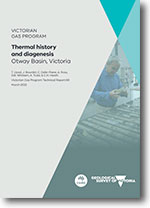VGP Technical Report 69 - Thermal history and diagenesis, Otway Basin, Victoria.
 |
| |||||
Product description:About the Victorian Gas Program: The Victorian Gas Program (VGP) is a comprehensive science-led program, incorporating geoscientific and environmental research to assess the risks, benefits and impacts of potential onshore conventional gas exploration and production. The program is also investigating the potential for further discoveries of onshore conventional and offshore gas in the Otway and Gippsland geological basins and assessing the feasibility of additional onshore underground gas storage in depleted reservoirs around the Port Campbell area. The VGP includes an extensive, proactive and phased community and stakeholder engagement program, through which the results of the scientific studies are being communicated. Executive summary: As part of the Victorian Gas Program (VGP), the Geological Survey of Victoria (GSV) and Commonwealth Scientific and Industrial Research Organisation (CSIRO) entered into a collaborative research agreement with the objective of developing a more comprehensive understanding of the distribution and characteristics of potential hydrocarbon source rocks, their thermal history, and the generation and migration of petroleum in the Otway Basin. The thermal history of a sedimentary basin, particularly the occurrence of discrete heating episodes, provides a framework for evaluating the timing of generation, expulsion and migration of hydrocarbons from potential source rocks. The clay minerals in sedimentary rocks can provide information about the thermal evolution of the basin and, through radiogenic isotope dating methods, the timing of specific heating episodes. Optical petrography provides the diagenetic history of potential reservoir rocks and insights into reservoir effectiveness. Fluid inclusions trapped by authigenic minerals can constrain the relative timing of hydrocarbon migration and diagenesis and provide the temperature and pressure conditions at the time of entrapment. CSIRO undertook a sampling program comprising sixty-six samples from twenty-three wells located in the Victorian part of the onshore Otway Basin and adjacent offshore waters administered by the Commonwealth. In addition to optical petrology, the samples were analysed by X-ray diffraction (XRD), scanning electron microscopy (SEM), and quantitative mineral analysis. Radiogenic isotope dating of diagenetic clay minerals, stable isotope analysis of calcite vein minerals, fluid inclusion microthermometry, and Raman spectroscopy of fluid inclusions were undertaken on selected samples. Potassium-argon dating of illitic clay minerals has identified three discrete thermal events between 110 Ma and 85 Ma (Albian to Santonian). The earliest event (110 Ma to 105 Ma) appears to mainly affect the eastern part of the basin and is interpreted to be related to extension and sag of the Otway Basin during deposition of the Eumeralla Formation. A second event between 95 Ma and 90 Ma reflects the effect of renewed rifting during the Turonian, while illite ages of approximately 85 Ma are likely to be related to the separation of the Australian and Antarctic continents, and the earliest appearance of oceanic crust in the Bight Basin to the west. Distinct fabrics, mineralogy and diagenetic processes were observed in sandstones from the Pretty Hill, Eumeralla and Waarre formations which result from the differences in the abundance and nature of the feldspar grains inherited from the depositional environment and provenance of the sediments. Feldspar stability is affected by increasing overburden and the hydrolysis of unstable grains during diagenesis which promotes the precipitation of authigenic clays in arkoses and litharenites, whereas quartz cements are likely in quartzarenites. Reservoir quality in the sandstones is mainly controlled by sedimentary facies, maximum depth of burial and pore-water salinity. High homogenisation temperatures were detected in fluid inclusions from the Otway Ranges, Port Campbell Embayment and Merino High, while anomalous fluid inclusion pressures suggest up to 500 metres of additional burial and exhumation in the Port Campbell Embayment. The heating rate varies geographically across the Otway Basin, and is substantially higher in the Otway Ranges (Anglesea-1A) compared to elsewhere in the basin. Fluid inclusions hosted in fracture-filling vein calcite in the Eumeralla Formation at Anglesea-1A and Hindhaugh Creek-1 have K-Ar ages of 90 Ma. These inclusions exhibit high homogenisation temperatures, and 87Sr/86Sr ratios typical of mantle-derived fluids. Fractures of the same age in Fergusons Hill-1 and Anglesea-1A have coeval methane and oil-filled inclusions and bitumen and are evidence of an active petroleum system and migration of hydrocarbons at this time in the eastern Otway Basin. However, uplift and cooling in the mid-Cretaceous led to the termination of hydrocarbon generation from Early Cretaceous source rocks in the eastern Otway Basin, with the petroleum system remaining inactive since. The evolution of this localised, early petroleum system in the eastern part of the Otway Basin appears to have been strongly influenced by the interaction between rigid basement blocks and the Late Cretaceous rift developing along the southern margin of Australia. Bibliographic reference: Uysal, T., Bourdet, J., Delle-Piane, C., Ross, A., Whittam, D.B., Todd, A. & Heath, C.H., 2022. Thermal history and diagenesis, Otway Basin, Victoria. VGP Technical Report 69. Geological Survey of Victoria, Department of Jobs, Precincts and Regions, Melbourne, Victoria. The downloadable version of this report is supplied in PDF format (17 MB) & Att A1 (XLSX 115 KB). | ||||||

